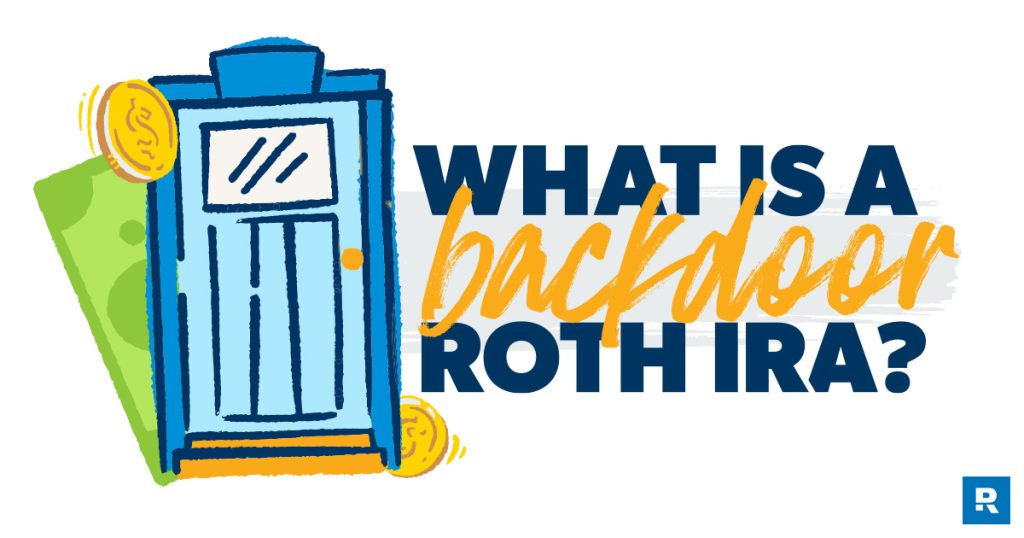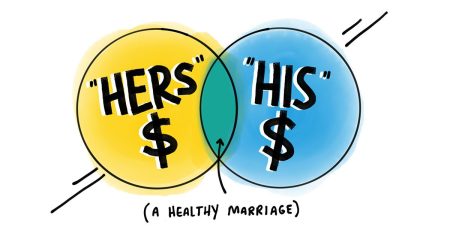The Roth IRA is one killer way to save for retirement. We recommend it a lot. Like, a lot a lot.
Because what’s not to love? Not only do you get to enjoy watching your investments inside of a Roth IRA grow tax-free, but you’ll also get to use that money in retirement without paying any taxes on it. It’s the best of both worlds!
The downside? The IRS rules that high-income earners can’t contribute to a Roth IRA (more on that below). . . not directly, anyway. But you can get around that hurdle with a backdoor Roth IRA.
What Is a Backdoor Roth IRA?
A backdoor Roth IRA is a different strategy as opposed to a different type of account. It’s a convenient workaround that bypasses the income limits on contributing to a Roth IRA.
If you make too much money (which doesn’t have to be Bill-Gates-level income, by the way) to open a Roth IRA, you can go through the back door by putting your money into a traditional IRA and then converting the money over to a Roth. That’s all there is to the backdoor Roth IRA! And it’s 100% legit.
Roth IRA vs. Traditional IRA
The list of reasons why we recommend going with a Roth over a traditional IRA is pretty long, but the most important difference between these two retirement accounts is how they’re taxed.
- When you put money into a traditional IRA, those contributions are pretax. So you get a tax break now, but the bad news is that when you start withdrawing money during retirement, you’ll owe Uncle Sam taxes on your contributions and any growth!
- On the other hand, with Roth IRAs, any contributions (or money that’s transferred in from another account) is considered after-tax. So when you make a contribution (or transfer money from a traditional retirement account) to a Roth IRA, you don’t get a tax break now, but you do get to enjoy tax-free withdrawals later.
Roth IRA Income Limits
The IRS sets yearly income limits that keep high-income earners from contributing to Roth IRAs. Here’s where the limits stand for 2024.1 Those “not eligible” spots on the chart are the reason the backdoor strategy came to be—as a way to give more income earners access to the Roth IRA.
|
Filing Status |
Yearly Income (Minus Deductions) |
Allowed Roth IRA Contributions |
|
Married Filing Jointly |
Less than $230,000 $230,000–240,000 $240,000+ |
Full Amount Reduced Amount* Not Eligible |
|
Married Filing Separately (and you lived with your spouse at any time during the year) |
Less than $10,000 $10,000+ |
Reduced Amount* Not Eligible |
|
Single, Head of Household, Married Filing Separately (and you didn’t live with your spouse at any time during the year) |
Less than $146,000 $146,000–161,000 $161,000+ |
Full Amount Reduced Amount* Not Eligible |
*The reduced amount is a multi-step calculation and depends on your income.2
How to Create a Backdoor Roth IRA
We’ll admit, even the name “backdoor” IRA sounds a little insider-y—but the truth is, it’s pretty simple and completely legal. You can convert a traditional IRA into a Roth IRA in just a few easy steps:
Step 1: Open up a traditional IRA.
If you don’t have one yet, you can connect with an investment professional who can help you set up a traditional IRA account and make your first contribution.
Step 2: Convert the traditional IRA funds into a Roth IRA.
Once you have money in your traditional IRA, you have to convert those funds into a Roth IRA. There are three ways to get that done:
- Same-trustee transfer: Are your IRAs with the same financial institution? Fantastic! All you have to do is tell your financial institution to transfer the money from your traditional IRA into the Roth account.
- Trustee-to-trustee transfer: If you have your traditional and Roth IRAs at different financial institutions (or want to open a new Roth account at a different institution), you can have the institution that holds your traditional IRA transfer the money to the Roth at the other institution.
- Rollover: In this scenario, you’ll get a check from your IRA provider and you’ll have to deposit that money into a Roth account within 60 days. Doing a backdoor Roth this way is riskier because if you forget to deposit that money for whatever reason, you’ll have to pay a withdrawal penalty on top of the taxes you owe.
Again, if you have a bunch of money already inside a traditional IRA and want to convert all of it to a Roth, you can. While there are IRA contribution limits each year, there are no restrictions on how much you can convert from an existing investment account to a Roth IRA.
But as we mentioned before, you have to pay taxes on all the money you convert into your Roth account. Which brings us to . . .
Step 3: Pay the taxes you owe on the money you invested.
Some people get this idea that doing a backdoor Roth IRA is some kind of tax dodge. But that’s not the case at all—you’re just deciding to pay your taxes on your retirement savings now instead of later.
So if you put $5,000 into a traditional IRA and convert that into a Roth IRA, come tax season, you’ll have to pay taxes on that $5,000 plus whatever your investments earned while they were in the traditional IRA.
And heads up! The money you’re converting will probably count as income for the year and—depending on how much you earn and how much money you’re converting—it might bump you into a higher tax bracket for the year.
Talk with an investing or tax professional who can give you an idea of how much you’ll owe in taxes when you do the conversion. That way, you won’t have a panic attack when you get your tax bill next April!
Step 4: Repeat the process every year and enjoy tax-free growth!
That’s it! Contribute. Convert. Pay your taxes. And then do it all over again year after year so you can enjoy watching your investments grow tax-free.
Ramsey Solutions is a paid, non-client promoter of participating pros.
Is a Backdoor Roth IRA Worth It?
So, is it worth the trouble of converting funds from your traditional IRA into a Roth IRA? Let’s weigh the pros and cons.
Disadvantages of a Backdoor Roth IRA
- Changes to your tax bill: When you convert from a traditional to a Roth IRA, you have to pay taxes on that money because the money wasn’t taxed before you put it into the traditional IRA. Make sure you have the cash on hand to pay those income taxes—do not use money from your investments to pay your tax bill!
- Contribution limits: You can’t invest more than $7,000 in an IRA in 2024 ($8,000 if you’re 50 or older).3 But remember: If you already have a traditional IRA, there’s no limit on how much you can convert from that account to a Roth IRA each year. Heck, you could convert $50,000, if you had it, from a traditional IRA to a Roth. You’d pay a hefty tax bill, but you could do it as long as you had the cash to cover it!
Advantages of a Backdoor Roth IRA
There are some big advantages to using the backdoor Roth IRA strategy.
- No income limit to start the traditional IRA: Everyone who earns an income is eligible for a traditional IRA—which means no income limit on who can take advantage of a backdoor Roth IRA.
- No required minimum distributions (RMDs): Roth IRAs have no RMDs, which is a certain amount of money you must withdraw from some retirement accounts (including traditional IRAs) when you hit retirement age. For 2024, you have to begin taking RMDs at age 73. But Roth IRAs don’t have RMDs, which is great news! That means your money can continue growing tax-deferred until you’re ready to start withdrawing, whether you’re 73 or 93. And you can take out as little or as much as you want.4
- Tax-free gains and withdrawals: If you convert your traditional IRA funds to a Roth, you pay the taxes up front, which will likely be less than what you’d pay if they were taxed down the road. You get to enjoy tax-free growth and withdrawals (as long as you wait till you reach age 59 1/2 to withdraw).
Still on the fence about doing a backdoor Roth? Let’s run some numbers.
Say you’re 40 years old, single, and you don’t qualify for making Roth IRA contributions because you’re over the income limit. But you do have $125,000 sitting in a traditional IRA. You’re unsure about whether to leave it or convert it to a Roth.
Currently, the average income tax rate for the top 10% of taxpayers in the U.S. is roughly 20% (to keep things simple, let’s say that average tax rate will stay the same in the future).5
If you go ahead with the backdoor Roth IRA strategy, you’ll owe around $25,000 in taxes to convert the entire $125,000 from a traditional IRA to a Roth IRA. Ouch!
But then your $125,000 can grow tax-free inside your Roth IRA and you won’t pay taxes on any of that investment growth when you take it out in retirement. The average annual rate of return of the stock market is between 10–12%.6 So if you don’t invest a single dollar more, that $125,000 will grow by more than $1.9 million over the next 25 years . . . and you won’t pay taxes on any of it.
What if you choose to leave that $125,000 in a traditional IRA instead? Well, then you’ll have to pay taxes on that original $125,000 and all that investment growth when you take money out in retirement.
So if you retire at age 65 and started taking out $65,000 each year for the next 20 years from your traditional IRA, you’ll likely end up paying around $260,000 in taxes total over that period of time.
That $25,000 you paid to do a Roth conversion 25 years ago looks pretty good right about now, doesn’t it?
When Does It Make Sense to Do a Backdoor Roth IRA?
We love the idea behind a backdoor Roth IRA. After all, who wants to worry about paying taxes on their withdrawals in retirement? Not us! But the truth is, a backdoor Roth IRA isn’t for everyone.
It’s definitely in your best interest to strictly follow the rules around a Roth—otherwise, you could take a hit on your investment, and that’s not what you want! Talk it through with your financial advisor before you take the leap.
If you’re not careful, a backdoor Roth could actually cause some financial headaches right now. Here are the three conditions you need to meet if you want to successfully execute a backdoor Roth IRA:
1. You don’t plan to retire for at least another five years.
Thanks to the IRS’s withdrawal rules, you need to wait at least five years before you can take out money from your account once you convert money from a traditional IRA to a Roth IRA—any sooner, and you’ll likely owe taxes and pay a hefty penalty.7
If you need to withdraw the money in your IRA fairly soon, you probably need to rethink this backdoor strategy.
2. You have the cash on hand to pay the tax bill.
We can’t stress this point enough: You should only do a backdoor Roth IRA if you have the cash on hand to pay the taxes you owe. Do not—we repeat, do not—take money out of the traditional IRA itself to do so. That would just undercut your future gains, defeating the whole purpose of the conversion.
This is where a lot of people get tripped up. They get so excited about the tax benefits of a Roth IRA that they forget about the hefty tax bill that’s waiting for them on Tax Day because of the conversion.
Let’s put it this way: If you’re in the 24% tax bracket, maxed out a traditional IRA in 2024, and decided to do a backdoor Roth IRA at the end of year, that means you’re going to owe an additional $1,680 in taxes when you sit down to file your taxes in the spring. And that number will be higher if the conversion knocks in into a higher tax bracket (or if you’re in a higher tax bracket already).
3. You have no debt at all (including your mortgage).
Yup, you read that right. No debt. Not even a mortgage. That means you’re on Baby Step 7 and have more margin in your budget to make some headway on your retirement goals with a backdoor Roth IRA without it getting in the way of other important financial goals (like saving for your children’s college funds and paying off your mortgage early).
When you don’t have any debt payments, it’s a whole lot easier to pile up the cash you need to cover the taxes you would owe once you move your money from a traditional IRA to a Roth IRA.
But since a backdoor Roth IRA could have a huge impact on your financial situation and investing strategy, it’s worth talking to a financial advisor first before you make any final decision.
This article provides general guidelines about investing topics. Your situation may be unique. To discuss a plan for your situation, connect with a SmartVestor Pro. Ramsey Solutions is a paid, non-client promoter of participating Pros.
Read the full article here










